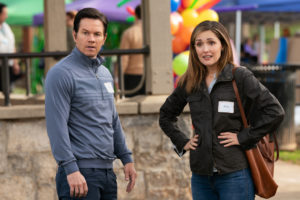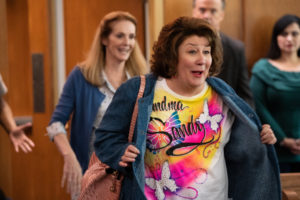
Director and co-writer Sean Anders new film “Instant Family” is based partially on him and his wife’s real-life experiences with foster care prior to the adoption of their three children who are biological siblings. The film stars Mark Wahlberg and Rose Byrne as parents of three foster siblings highlighting the ups and downs they encounter with the system. At its core, this heartwarming film is important as it sheds a spotlight on parentless, or absent parents of siblings in foster care, and takes away the false stereotypes that are associated with foster kids.

Our interview took place in Chicago at the lavish Park Hyatt Hotel, on November 7, 2018. An adoption consultant Maraide Green, was also present for the interview. She’s a student at UCLA studying to be a writer and a product of foster care and adoption. Maraide studied drafts of the script checking for authenticity; she served as a consultant on set during the filming.
Sean Andres is known for his comedic work, most recently “Daddy’s Home”(2015) and “Daddy’s Home 2”(2017), so to tackle the serious topic of foster care and adoption no doubt seems to some, a little out of his league. After viewing “Instant Family” and knowing Andres backstory, the film is absolutely a perfect match for him. It appears that he has met his goal of changing the stereotype that surrounds a foster child, and has enlightened us on the topic of sibling foster children.

As it turns out, Sean and I have a connection with the location of where he was born as my family has a vacation home not far from his town. My first question inquired about his family roots.
Sean said, “I grew up in Deforest, Wisconsin, which is a small town outside of Madison, Wisconsin. My wife is also from that same small town. We didn’t go to high school at the same time. She was a friend of my sister’s, and I met her that way. So, we both still have family there, and we still return back there often.”
“In fact, our first family trip with our kids was back to Wisconsin, and that trip was really the trip that solidified us, where when we got back from that first vacation, that first summer trip back to Wisconsin was when we really felt like a family for the first time. That’s why in the movie when you see you the squirt gun fight, that’s inspired by our trip to visit our parents, and for the kids to meet their grandparents.”
It’s always interesting to me to interview a director who is also a writer, I asked about his writing and what he enjoys most about the writing process?
Sean replied, “I’ve been writing comedy mostly, and it always incorporates relationships and drama, and in my case, family. I work with a writing partner, and we get together every day, and we talk about whatever our ideas are, and then we bang them out as best we can. It’s a lot of pain and frustration with rewriting over and over again. But, we enjoy the process, but it’s a difficult one.”
On the topic of directing, Sean said, “I’ve always felt like I was good at a lot of different things, but not great at any one thing. Directing is a great job for somebody who’s a bit of a jack-of-all-trades, because I’m interested in every facet of it, from camera to costumes to the writing process, to the actors. As a director, you get to surround yourself with all these incredibly talented specialists, and you get to be the one who’s guiding that ship, and I really like that process. I also really like trusting the people that I work with and letting them be important parts of the process.
When asked about Mark Wahlberg and what he brought to the film Sean was very appreciative.
“We’re here because Mark said yes, honestly. I stayed up late one night writing him this impassioned email about this movie and why it meant so much to me, and Mark called me the very next morning and just said, “Yes.” He said he had met kids in foster care over the years that had really had an effect on him. Knowing that we were going to have an actor that can handle all the twists and turns and the ups and downs of this movie and also be really funny was great.”
When asked if the character of Grandma Sandy was in the script from the beginning Sean beamed.
Sean said, “We wanted to have a character that was a little bit inspired by my own mom, who was going to be that character that was just going walk in the door and claim the kids the second she showed up.”

I then asked Sean to talk about the current statistics in adopting foster kids, and relationships of siblings, and how he thinks that we can solve this problem in this country?
Sean said, “The numbers obviously are always in flux, but give or take, there are about a half a million kids in foster care right now. Out of those kids, about 100,000 of them are what you would consider potentially adoptable. The other 400,000, you know, the hope with those kids is that they’re going to be able to be reunited with their birth families. But, of those 100,000, there are kids that risk aging out of the system and having to start their lives no support.”
“I realize that 100,000 sounds like a big number, but the reality is that most of those kids are parts of sibling sets. You’re really talking probably, 40,000 sibling sets, and probably not even. So, in a nation of over 300 million people, 40,000 sibling sets is very doable.”
Sean Andres continued, “But, the thing that has to change and this is what I’m hoping the movie will change, is that people just have to stop being afraid of these kids, and they have to think of these kids as just kids. I think Maraide could speak to that. She was speaking about it very eloquently a moment ago.”
Maraide said, “Well, there’s just a lot of stereotypes around the kids that grow up in foster care, and that isn’t true. Most of these kids are great kids who are very smart, are very athletic. They have a lot of great qualities, but people are so afraid of them because they think that because they had a traumatic childhood that they’re just going to be destructive the rest of their lives, but that’s not true at all, they need people that love them and support them.
The foster parent group sessions in the film were telling, I asked about showing the tough times with the good.
Sean said, “That’s all very real. That’s one of the benefits of adopting through foster care that in most places, they have these built-in services to help you out, including support groups where you get together, and you just get to vent a little bit about the frustrations and the problems that you’re having, but you also get to talk about the good things that are going on, and you come away from that feeling rejuvenated and ready to get back at it.”
In closing, Sean said, “I’ll leave you with this, what I hope this movie accomplishes is exactly what Maraide referred to if people’s attitudes towards these kids in the system change then that’s great. But, of course, we’re not expecting everyone who goes to see the movie to run out and adopt kids, but at least if their attitude changes, or if someone they know, or if someone in their family decides to go this route, that they might be more supportive, hopefully in the future after seeing this movie.”
Sarah Knight Adamson© November 7, 2018
